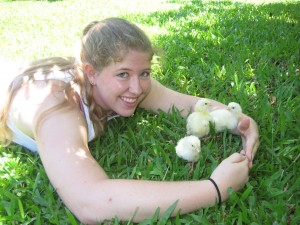KSTR Sustainability Project

By Volunteer Rachel Melvin
Kids Saving the Rainforest is focused on preserving and protecting the local wildlife. This mission includes housing a wildlife sanctuary on the grounds of the Blue Banyan Inn on the property that is called “the finca”. The sanctuary currently houses 29 monkeys plus a crab eating raccoon. Feeding them, as well as the volunteers that care for them, and BBI’s numerous guests can take an extraordinary amount of food.
KSTR strives to implement a more sustainable operation on the Finca and our next venture in this arena is creating a sustainable egg supply to feed monkeys, volunteers, and guests.
This journey began with the construction of a chicken coop, quickly named Casa de Pollo by the volunteers. Mono Azul employees and their three volunteer helpers built the coop. The roomy coop was sided with wire mesh and fencing to protect against predators but still allow a breeze to pass through and roofed to protect against the sun. These are important factors in a tropical climate as over-heated hens do not produce well. The floor was left open except for an elevated platform housing the individual nest boxes for the hens to roost at night and hopefully for the volunteers to gather eggs from in the morning. The floor will soon be lined with concrete to facilitate easy cleaning and protect from burrowing predators (after eggs or hens). Even though the Mono Azul boys probably feared for their lives at times because of leaving the tools in the hands of us Gringa girls, the construction was completed with no mishaps and few injuries (mostly just bruised thumbs from hammering).
The next step was to secure a laying population, which was started with three baby chicks soon dubbed Suzie, Rachel, and Jenny (after the volunteers present on their arrival). As the sex of the chicks is incredibly hard to determine at such young age, this was more of a fun pet project for the volunteers, of which I was an avid campaigner, having never seen or held a baby chick before. The three chicks will soon be grown to 23 with the addition of 20 confirmed laying hens.
On their arrival the chicks were placed in their new home for the next six weeks, a large cardboard box. The box was lined with newspaper and shredded paper to act as bedding and a large continuous feeder and water were placed in the box. At night a ceramic heat lamp was added to make sure the chicks stayed a balmy 100 degrees Fahrenheit throughout the night so all their energy was focused on growing and not staying warm. Each day the chicks were taken out into the yard to explore and try different foods, including small rocks also known as grit, which is essential for their diet to facilitate digestion in their gizzard (the muscular gizzard and the grit essential grind the feed aiding the gastric juices to digest the food). The chicks were well cared for and happy. They loved each other’s company and became distressed when separated for daily cleaning. Research says they will continue to prefer each others company over other chickens as they grow up together and I, for one, am very excited to test this theory when they are placed in the coop with the other hens.
For weeks we watched them grow and change, Suzie was the largest chick at the beginning named after our 6-foot tall volunteer! As the weeks passed her companions soon surpassed her, with Jenny current holding the title of Gordito. Recently our little balls of fluff have entered a new stage of development. The very awkward stage we have deemed the teenage years due to their awkward and gawky appearances, have grown their adult white feathers and lost their yellow fuzz around their bodies. They are on their way to adulthood but still retain their small and yellow head, looking like 2 halves of different chickens. They are about 4 weeks old at the moment and still growing quickly. Having gotten too big to pick up and hold easily, reality is setting in that I will soon have to transfer my baby chicks to their new coop and only see them during a daily egg collection. But I’m proud that they will help KSTR on its mission to become more sustainable and feed the Finca.

